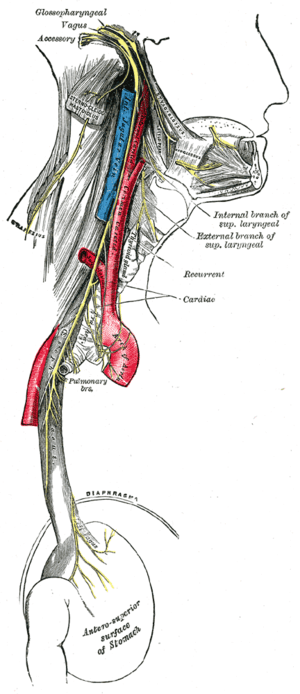External laryngeal nerve
| External laryngeal nerve | |
|---|---|
 Course and distribution of the glossopharyngeal, vagus, and accessory nerves. (External branch of superior laryngeal labeled at center right.) | |
| Details | |
| From | superior laryngeal nerve |
| Innervates | cricothyroid muscle, pharyngeal plexus |
| Identifiers | |
| Latin | ramus externus nervi laryngei superioris |
| TA | A14.2.01.161 |
| FMA | 6243 |
The external laryngeal nerve is the smaller, external branch (ramus externus) of the superior laryngeal nerve. It descends on the larynx, beneath the sternothyroid muscle, to supply the cricothyroid muscle.
It functions to tense the vocal cords by activating the cricothyroid muscle, increasing pitch.
It gives branches to the pharyngeal plexus and the superior portion of the inferior pharyngeal constrictor, and communicates with the superior cardiac nerve behind the common carotid artery.
Clinical significance
The external branch is susceptible to damage during thyroidectomy or cricothyrotomy, as it lies immediately deep to the superior thyroid artery. The ability to produce pitched sounds is then impaired along with easy voice fatigability, (usually mono-toned voice). Damage to the superior laryngeal nerve leaves the vocal cord abducted and poses an aspiration risk.
External links
- 1328873530 at GPnotebook
- Maranillo E, León X, Quer M, Orús C, Sañudo J (2003). "Is the external laryngeal nerve an exclusively motor nerve? The cricothyroid connection branch". Laryngoscope. 113 (3): 525–529. doi:10.1097/00005537-200303000-00024. PMID 12616208.
- Overview at sprojects.mmi.mcgill.ca
- cranialnerves at The Anatomy Lesson by Wesley Norman (Georgetown University) (X)